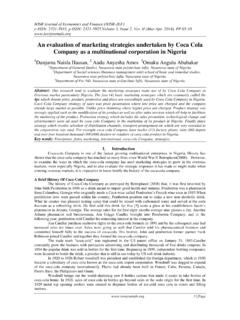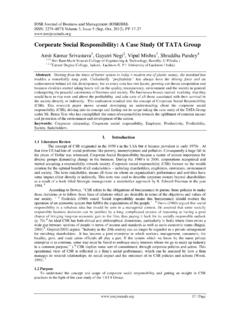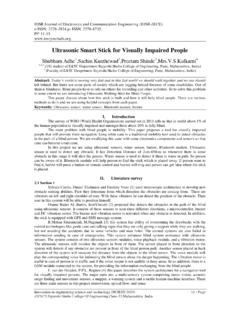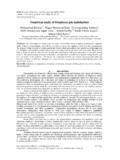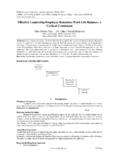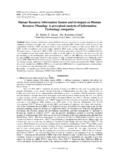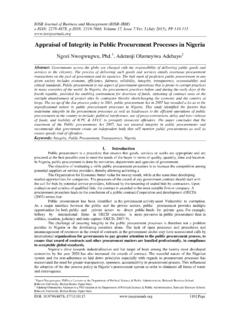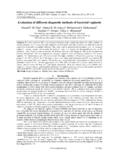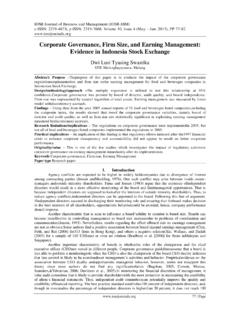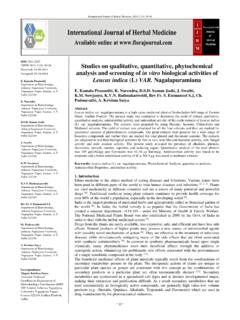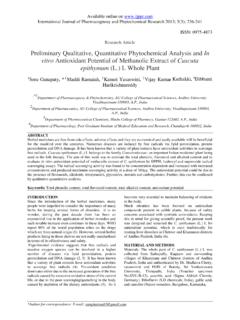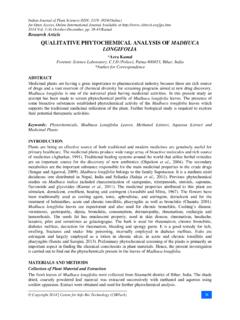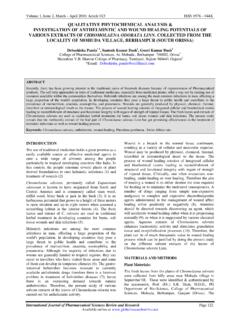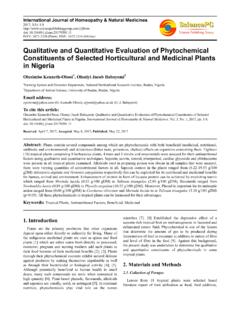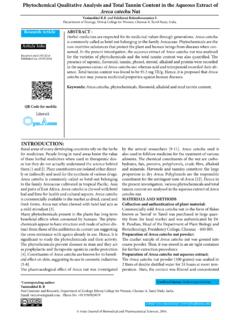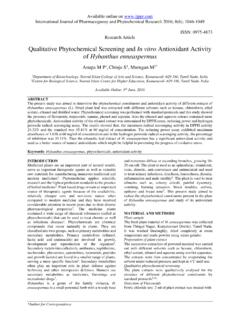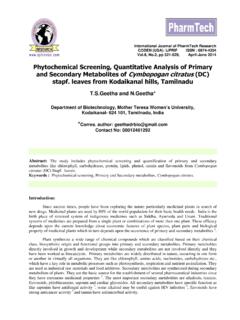Transcription of Qualitative Phytochemical Analysis and in Vitro Fungal ...
1 IOSR Journal of Pharmacy and Biological Sciences (IOSR-JPBS) e-ISSN:2278-3008, p-ISSN:2319-7676. Volume 11, Issue 3 Ver. III (May - ), PP 68-72 DOI: 68 | Page Qualitative Phytochemical Analysis and in Vitro Fungal Activities of Citrus aurantifolia L. and Carica papaya L. Leaves Extracts on Pathogenic Fungi Dimphna N. Ezikanyi1, Catherine V. Nnamani2, Joy N. Ihejirika3 1,2,3 Department of Biological Science, Faculty of Science, Ebonyi State University, Abakaliki, Ebonyi, Nigeria Abstract: The use of medicinal plants, which have fewer side effects and economically cheaper, have been taken into consideration recently. Citrus aurantifolia and Carica papaya leaves are not only known for their nutritional benefits but also considered to possess medicinal properties. The main aim of the study was to determine the antifungal activities of Citrus aurantifolia and Carica papaya leaves on some pathogenic fungi (Aspergillus, Candida and Penicillium) isolated from female genital tract.
2 Leaves of Citrus aurantifolia and Carica papaya were collected from Onu-Ebonyi in Ebonyi State. Three different concentrations (300 mg/ml, 150 mg/ml and 75 mg/ml ) of leaves ethanol extract were prepared and introduced into bored holes of organisms cultured on potato dextrose agar(PDA). The result showed that leaf extract of lime had higher zones of inhibition diameter on three fungi species compare to leaf ethanol extract of Carica papaya. There were increase on zones of inhibition of both leaves extract as the concentration increases from 75 mg/ml to 300 mg/ml. Phytochemical screening indicated the presence of flavonoids, alkanoids, tannins, saponin and protein in Carica papaya but alkanoids and tannins in Citrus aurantifolia. The result showed that Citrus aurantifolia and Carica papaya possess antifungal activities but Citrus aurantifolia showed more inhibitions on Aspergillus, Candida and Penicillium than Carica papaya.
3 Keywords: Fungi, Inhibition, Citrus aurantifolia, Carica papaya, Isolates I. Introduction The importance of herbs in the management of human ailments cannot be over emphasized. It is clear that the plant kingdom harbours an inexhaustible source of active ingredients valuable in the management of many diseases. Most plants have medicinal values and the active components are normally extracted from all plant structures; the leaves, stems, barks, roots, corms, rhizomes, woods, flowers, fruits or the seeds, however the concentrations of these components vary from structure to structure. The parts known to contain the highest concentration of chemical constituents are preferred for therapeutic purposes (Kafaru, 1994). Some of the active principles singly or in combination inhibit greatly the life processes of microbes, especially the disease causing ones. They do this by binding their protein molecules, acting as chelating agents (selective binding polyvalent metal ions so that the latter loses its biological activities), altering their biochemical systems, preventing utilization of available interests to the microorganisms, others cause inflammation of microbial cells (Garrod et al.)
4 , 1995). The bitter taste, pungent and repulsive smell in some plants; have been found to have repressive ability over the metabolic activities of a wide range of microorganisms (Mitscher et al., 1992;Sofowora, 1982 ; Baladrin et al., 1985). The use of medicinal plants predates the introduction of antibiotics and other modern drugs into the African continent. The active components plants are expected to be inimical to the growth of at least some microorganisms especially the disease causing ones Escherichia coli, Staphylococcus aureus, Proteus mirabilis, Klebsiella pneumoniae, Pseudomonas aeruginosa etc. therefore, many studies and researches had been done on the antimicrobial properties of many plants (Okafor, 1991). Carica papaya is a herbaceous fruit crop belonging to the family Caricaceae, pawpaw is the fruit of the plant Carica papaya, the only species in the genus Carica of the plant family Caricaceae.
5 It is native to the tropics of the Americas, mostly grown in tropical and subtropical regions (Aravind et al.,2013). It is distributed through out Asia, Nigeria etc. (Afolayan, 2003) . The ripe fruit of papaya is usually eaten raw, without the skin or seeds but the unripe green fruit can be eaten cooked, usually in curries, salads and stews (Okafor, 1998). The plant is also described in a documented property forms and it act as analgesic, amebicide, antibacterial, cardiotonic, cholagogue, digestive, emenagogue, febrifuge, hypotensive, laxative, pectoral, stomachic and vermifuge. It is also a rich source of three powerful antioxidant, vitamin C, vitamin A and vitamin E; the minerals; magnesium and potassium, it contains B vitamin, pantothenic acid, folate and fiber. In addition to all this, it contains a digestive enzyme -papaintha which effectively treats causes of trauma, allergies and sports injuries (Aravind et al.)
6 , 2013) . The edible part of papya is widely used all over the world . The unripe fruit of Qualitative Phytochemical Analysis and in Vitro Fungal Activities of Citrus Aurantifolia L. DOI: 69 | Page papaya is used as mild laxative and abortifacient agent and leaves are used for treatment of pyrexia, diabetes, gonorrhea, syphilis, inflammation and as a dressing component for wounds (Gill,1992) Many biologically active Phytochemical have been isolated from papaya and studied for application, almost all parts of the papaya (leaves, latex, seed, fruit, bank, peel, roots) have important biologically active substances that can be isolated for application predominantly in the pharmaceutical industry. Different parts of the plant are attributed with different medicinal values, for example, the seed are effective as a vermifuge and in the treatment of hypertension, diabetes mellitus and hyper cholesterolemia.
7 The fresh leaves are also efficacious in the treatment of gonorrhea, syphilis and amoebic dysentery. Results from studies on biological activities of C. papaya plants extracts and isolated compounds showed that the latex and root extracts inhibited Candida albicans (Flath and Forrey, 2007). Citrus aurantifolia (lime) belongs to family Rutaceae, the fruit is green in colour and oval or round shape with a diameter between one to two inches. Limes can either be sour or sweet, sour limes possess a greater sugar and citric acid content than lemons and feature an acidic and tart taste, while sweet limes lack citric acid content and are sweet in flavor (Loizzo et al., 2012). It is an essential ingredient in the preparation of most herbal concoction; it is also used to suppress stomach ache. When added to sugar and palm oil or to honey, the juice has been found to be an excellent cough relieving mixture.
8 The rind is burnt in some homes to act as insecticides against mosquitoes (Aibinu et al., 2007). There is limited studies on the medicinal value of lime leaf The aim of the study is to determine the antifungal activities of pawpaw and lime leaves on fungi (Penicillium; Aspergillus and Candida) isolated from female genital tract. II. Materials and Methods Collection of Specimen Permission was obtained from the hospital and patients consent was sort prior to sampling. Each female was asked to recline on the examination bed and open legs wide. A sterile swab was inserted into the vaginal wall, rotated for few seconds before it was withdrawn. The swab sticks were then put back into the container, represented with alphabets, specimen were transported to the laboratory immediately, and stored in the refrigerator prior to medium preparation. Potato dextrose agar media were prepared, an inoculum pool was made using distilled water with swab specimen to get a homogenized mixture.
9 Then a sterile syringe was used to pipette 1 ml of the mixture to spread on the plates. The most preponderant fungi (Candida, Aspergillus and Penicilluim) were selected for antifungal studies using Carica Papaya and Citrus aurantifolia Sample Collection and Preparation Fresh leaf samples of Carica papaya and Citrus aurantifolia were collected from Onu-Ebonyi in Ebonyi State and were transported to Applied Biology Laboratory. The leaves were thoroughly washed with sterile distilled water, and air dried at 28 oC for 2 hours. Both plant samples were dried in an oven at 45 oC for 30 minutes and then pulverized separately with a household blender. The crude extracts of the two plants were prepared using standard procedures (Fatope et al., 1999). This involved soaking 50 g of the powdered extract in 5 % ethanol for 48 hrs at room temperature to allow for maximum extraction of the components.
10 This was followed by evaporation of the filtrate to eliminate the solvent using a rotary evaporator. The residue was used as crude extract for each of the test plants and stored in reagent bottles in the refrigerator at 10- 12 oC until they were used. Three different concentrations of extract of Carica papaya and Citrus aurantifolia leaves (300 mg/ml, 150 mg/ml and 75 mg/ml ) and 5 % ethanol as control were prepared, 2 ml of extracts and control were introduced into the bored holes of pure cultures of organisms. Inhibition zones were measures with meter rule (cm) Qualitative Phytochemical Screening The chemical test for the Qualitative Analysis of Carica papaya and Citrus aurantifolia leaves were carried out using standard method. III. Result And Discussion Citrus aurantifolia leaves extract exhibited higher zones of inhibitions diameter compared to Carica papaya and control (5 % ethanol) on three pathogenic fungi.
